
Crisis on Infinite Earths is a 1985 to 1986 American comic book crossover series published by DC Comics. Written by Marv Wolfman and pencilled by George Pérez, it was first released as a 12-issue limited series from April 1985 to March 1986. As the main piece of a crossover event, some plot elements were featured in tie-in issues of other publications. Since its initial publication, the series has been reprinted in various formats and editions.

Wonder Woman is a superheroine created by the American psychologist and writer William Moulton Marston, and artist Harry G. Peter in 1941 for DC Comics. Marston's wife, Elizabeth, and their life partner, Olive Byrne, are credited as being his inspiration for the character's appearance.

Super Friends is an American animated television series about a team of superheroes which ran from 1973 to 1985 on ABC as part of its Saturday-morning cartoon lineup. It was produced by Hanna-Barbera and was based on the Justice League of America and associated comic book characters published by DC Comics. The title of the series varied from season to season, as did the superheroes on the team. Nine seasons, comprising a total of 93 episodes, were produced.
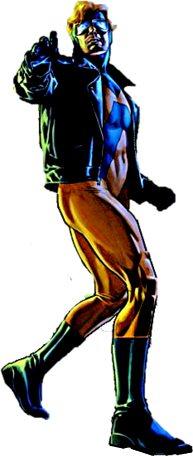
Animal Man is a superhero appearing in American comic books published by DC Comics. As a result of being in proximity to an exploding extraterrestrial spaceship, Buddy Baker acquires the ability to temporarily "borrow" the abilities of animals. Using these powers, Baker fights crime as the costumed superhero Animal Man.

Amazing-Man is the name used by four fictional characters published by DC Comics. The first three are African-American superheroes and are members of the same family. The first Amazing-Man debuted in All-Star Squadron #23, and was created by Roy Thomas and Jerry Ordway. The second Amazing-Man debuted in Justice League America #86, and was created by Dan Vado and Marc Campos. The third Amazing-Man debuted in Justice Society of America vol. 3 #12, and was created by Geoff Johns and Dale Eaglesham. The fourth Amazing Man debuted in OMAC vol. 3 #2, and was created by Dan DiDio and Keith Giffen.

"Infinite Crisis" is a 2005–2006 comic book storyline published by DC Comics, consisting of an eponymous, seven-issue comic book limited series written by Geoff Johns and illustrated by Phil Jimenez, George Pérez, Ivan Reis, and Jerry Ordway, and a number of tie-in books. The main miniseries debuted in October 2005, and each issue was released with two variant covers: one by Pérez and one by Jim Lee and Sandra Hope.

Donna Troy is a superhero appearing in American comic books published by DC Comics. She is the original Wonder Girl and later temporarily adopts another identity, Troia. Created by Bob Haney and Bruno Premiani, she first appeared in The Brave and the Bold #60. Donna has been commonly featured in stories involving the Teen Titans, which she originally joined during their second adventure and is since depicted as a founding member of the team.
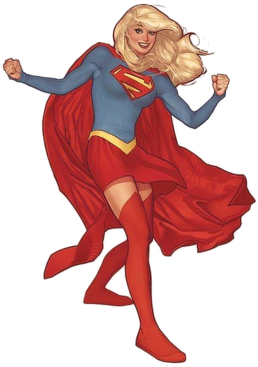
Kara Zor-El (Supergirl) also known by her adoptive names of Linda Lee, Kara Kent, Linda Lang, and Kara Danvers, is a superheroine appearing in American comic books published by DC Comics. She was created by Otto Binder and designed by Al Plastino. Danvers first appeared in the story "The Supergirl from Krypton" in Action Comics #252. Kara is the biological cousin of Kal-El, who went on to adopt the name of Clark Kent and the superhero identity Superman. Her father, Zor-El, is the brother of Superman's father, Jor-El. During the 1980s and the revolution of the Modern Age of Comics, Superman editors believed the character's history had become too convoluted, thus killing Supergirl during the 1985 Crisis on Infinite Earths event and retconning her out of existence.
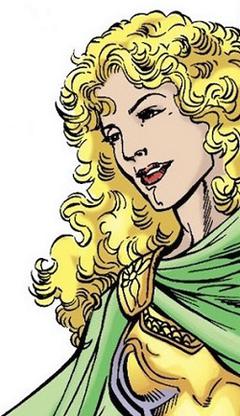
Antiope is a fictional character appearing in American comic books published by DC Comics, usually as a supporting character in stories featuring Wonder Woman and the Amazons of Paradise Island/Themyscira. Created by writer Dan Mishkin and visualized by artist Don Heck, she first appeared in Wonder Woman #312, and is based on the mythological Antiope, one of the mythological Amazons.

Doctor Cyber is a supervillain appearing in DC Comics publications and related media, commonly as a recurring adversary of the superhero Wonder Woman. She first appeared late in the Silver Age of Comics in 1968's Wonder Woman #179, written by Dennis O'Neil and illustrated by Mike Sekowsky and Dick Giordano.

Circe is a supervillain appearing in DC Comics publications and related media. Based upon the eponymous Greek mythological figure who imprisoned Odysseus in Homer's Odyssey, she is a wicked sorceress and major recurring adversary of the superhero Wonder Woman. She has been presented variously since first appearing in 1949’s Wonder Woman #37, though her characterization has consistently retained a key set of features: immortality, stunning physical beauty, a powerful command over sorcery, a penchant for turning human beings into animals and often, a delight in humiliation.

The character of Superman was created by Jerry Siegel and Joe Shuster, and has been continually published in a variety of DC Comics book titles since its premiere in 1938. There have been several versions of Superman over the years, both as the main hero in the stories as well as several alternative versions.
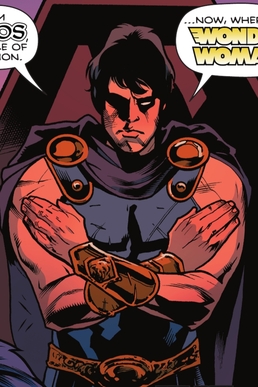
The Duke of Deception is a fictional character appearing in DC Comics publications and related media. Apparently based on Dolus, a deity of deceit and lies in Classical mythology, he is a longstanding recurring adversary of the superhero Wonder Woman. Introduced as a treacherous operative of the war god Mars / Ares in 1942’s Wonder Woman #2, the Duke would rise to become one of Wonder Woman's most persistent foes, appearing regularly in her adventures throughout the Golden, Silver and Bronze Age of Comics. His portrayal evolved into that of a figure autonomous from Ares, frequently confronting Wonder Woman and her allies as an independent antagonist with his own aims of conquest.

Tezcatlipoca is a name used by two distinct fictional characters appearing as supervillains in DC Comics publications and related media.

Robin of Earth-Two is an alternate version of the superhero Robin, who appears in American comic books published by DC Comics. The character was introduced after DC Comics created Earth-Two, a parallel world that was retroactively established as the home of characters which had been published in the Golden Age of comic books. This allowed creators to publish comic books taking place in current continuity while being able to disregard Golden Age stories featuring Robin, solving an incongruity, as Robin had been published as a single ongoing incarnation since inception. Unlike his main counterpart, Robin is the only alter ego of Dick Grayson, who uses the title into adulthood, rather than taking on later codenames such as Nightwing or Batman. In addition, the name "Robin" is not taken on by later characters.

Wonder Woman of Earth-Two is a fictional DC Comics superheroine, from the original stories by Wonder Woman writer and creator, William Moulton Marston and his wife Elizabeth Holloway Marston. After DC Comics established a multiverse in their published stories, which explained how heroes could have been active before World War II, retain their youth, and (subsequent) origins during the 1960s, this version of Wonder Woman was retconned merging with the original Wonder Woman who first appeared in All Star Comics #8.

The Children of Ares are several fictional characters appearing in DC Comics publications and related media, commonly as recurring adversaries of the superhero Wonder Woman. Primarily based on eponymous Greek mythological figures, they are malevolent progeny of Wonder Woman's nemesis, the war god Ares. Three in particular – Deimos, Phobos and Eris – have emerged as especially enduring characters, appearing in every era of Wonder Woman's comic book adventures since debuting in 1969's Wonder Woman #183. Beginning in the Silver Age of Comic Books, these three characters have often been presented as Ares’ principal legates in his campaigns for universal conquest, and have also confronted Wonder Woman on their own, individually as well as with one another, as antagonists independent of their father.
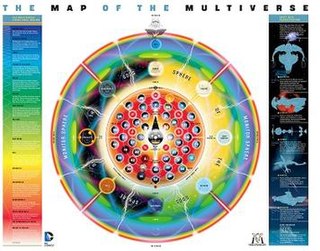
In most of the DC Comics media, the Multiverse is a "cosmic construct" that is composed of the many fictional universes the stories of DC media take place in. The worlds within the multiverse share a space and fate in common, and its structure has changed several times in the history of DC Comics.

Bizarra is a fictional character appearing in American comic books published by DC Comics. Bizarra first appeared in DC Comics Presents #71, in a story written by E. Nelson Bridwell with art by Curt Swan. The character is a distorted version of the superhero Wonder Woman, based on the Superman villain Bizarro. She is a very simple-minded being, has reversed character traits, believes women are inferior to men, and speaks in reverse of what her true meaning is.
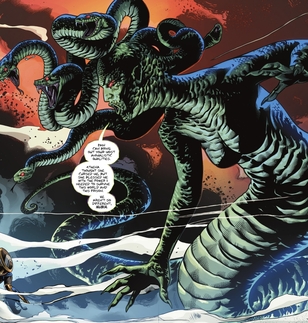
Medusa is a supervillain appearing in DC Comics publications and related media, commonly as a recurring adversary of the superhero Wonder Woman. Based upon the eponymous Greek mythological figure whose story was chronicled in Ovid's Metamorphoses, she is a snake-haired Gorgon with the ability to turn living creatures to stone with her gaze. Since her debut in 1964, Medusa's physical appearance has been presented variously as DC Comics' continuities have shifted and evolved. Though she has routinely been depicted with snakes for hair, she has sometimes been shown as bipedal and sometimes with a serpentine lower body. However across continuities, she has consistently been written with the ghostly ability to possess or influence other beings after her physical body has been killed, as well as an uncanny capacity for resurrection after death. Her characterization has been that of a dangerous immortal creature who is at turns both vengeful and sympathetic.




















